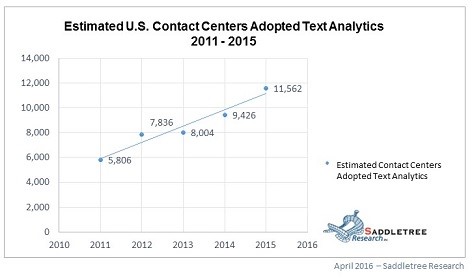Text Analytics Gaining Traction
The goal of many businesses for the past three decades has been to go paperless. While this is a worthy and environmentally-sound objective, it is not one that has been successfully met by most businesses. In fact, according to Coopers and Lybrand there are over four trillion paper documents in the U.S. alone and that number is growing at a rate of 22 percent, or about 880 billion paper documents a year.
In the enterprise back office, the flow of paper and paperwork has never really stopped and in many instances has been supplemented by on-line forms that still require an equal amount of effort as their hard copy counterparts to process. Meanwhile, the front office contact centre is experiencing a shift in business practices as a significant percentage of its traditional voice traffic shifts to text-based communications as customer preference moves from phone conversations to the convenience of e-mails, social media posts, and text messages.
Given the increase in text-based customer communications traffic as described in the paragraphs above, it is no wonder that text analytics is gaining traction in both the front office and the back office of the enterprise. In a nutshell, text analytics describes the process of extracting quality information from textual communications.
Text analytics turns text into data so it can be analysed and mined for information. It automates a previously tedious, time-consuming manual task, freeing workers to turn their attention to more creative or intricate tasks while simultaneously providing business intelligence that allows the enterprise to fine tune both front office and back office processes.
Saddletree Research has been actively following the progress of text analytics in the enterprise since 2011, when it became apparent that text analytics was going to have a lasting impact on customer service and back office workflows. We view the text analytics market in the same way we look at all market segments – from the end-user perspective. In other words, instead of asking vendors about their text analytics shipments, we ask users about their text analytics purchase history and/or technology acquisition intentions.
What we found in 2011 was nearly 6000 contact centres in the US that had already adopted text analytics. The graph below illustrates our estimation of the number of US contact centres that have adopted text analytics during the five-year period 2011 through 2015.

The graph shows growth of text analytics from nearly 6000 contact centre installations in 2011 to well over 11,000 installations by the end of 2015. This represents a five-year compound annual growth rate of 18.8 percent. The trend line indicates the continuation of this impressive growth trend in the future, but I would argue that growth will be considerably greater than expected.
The addition of artificial intelligence (AI) to the text analytics process is changing the game. Unlike most text analytics solutions that rely on forms or other structured data for interpretation, AI can interpret data through natural language process, applying reasoning and knowledge to any given text-based communication and automatically taking action on that communication.
Workflows are automated without human intervention and the AI-based text analytics solution continues to learn with each customer interaction, continually refining its ability to process information and increasing in efficiency over time. AI-based text analytics significantly increases efficiency via advanced capabilities that enable such benefits as less restrictive input requirements, advanced workflow automation, highly accurate data interpretation, and enhanced human capital productivity.
AI-based text analytics solutions have the potential to add sufficient value to the text analytics process that we can reasonably expect text analytics adoption in the contact centre to grow at a much higher rate than the 18.8 percent CAGR of the past five years. It is only a matter of time before the advanced capabilities provided by AI-based text analytics come to be expected by the industry, igniting what we expect to be an exciting period of growth for text analytics over the next five-year period.
There is a clear growth trajectory for the utilization of text analytics in the contact centre through 2018 and beyond.
Paul Stockford is Chief Analyst at Saddletree Research, Inc.
